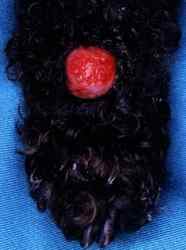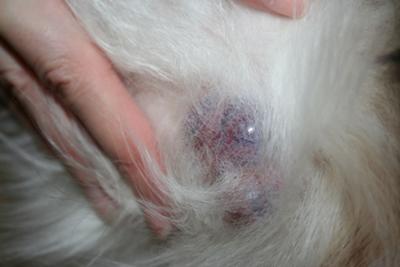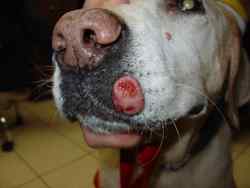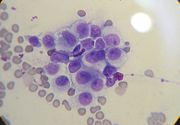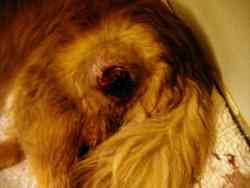We cover most types of dog cancer below, including each type’s physical description and common treatment.
Below, we’ll cover the following:
- What is a tumor?
- Understanding the difference between benign and malignant tumors
- Are certain dogs predisposed to dog cancer?
- Is the growth of a tumor reversible?
- Are there any holistic treatments available to cure dog cancer?
- Overview of different types of tumors and their common treatments
- What you should do next (after reading this entire page)
What is a Canine Tumor?
According to Dictionary.com, a tumor is “an abnormal growth of tissue resulting from uncontrolled, progressive multiplication of cells and serving no physiological function.” It obviously gets much more complicated than that…
Understanding the Difference Between Benign & Malignant Canine Tumors
In order to classify a tumor as benign or malignant, the tumor must be examined under a microscope in a lab. This is usually done by removing a small sliver of the tumor for examination.
Benign Tumors
The large majority of benign tumors are very slow growing and remain localized to one area of the body, usually causing little harm.
However, this does not mean that benign tumors should be ignored and deemed “safe”. There are certain circumstances when benign tumors can cause serious problems.
Despite the location, many veterinarians recommend the removal of benign tumors simply to play it safe and get rid of the growth. Most benign tumors can be easily and permanently removed.
Malignant Tumors
Malignant tumors, also referred to as cancerous neoplasms, tend to grow rapidly and are known to spread from one area of the dog’s body to another.
What differentiate malignant tumors from benign tumors are the characteristics of the cells. The cells of malignant tumors tend to have some degree of anaplasia. Anaplastic cells tend to be larger than normal cells and form themselves into bizarre shapes.
The nuclei, or center, of these anaplastic cells are usually very large and stained darkly. These cancerous cells infiltrate and destroy surrounding tissue and have the ability to transfer from one area of the body to another. When these cells transfer, they then produce secondary tumors called Metastases.
There are many methods of treatment for malignant tumors, but these, unlike benign tumors, cannot simply be removed through a one-day procedure. The treatment will be much more complicated and will involve a certain amount of risk, depending on the location, size and maturity of the tumor.
Are Certain Dogs Predisposed to Canine Tumors?
This is a very difficult question to answer.
There are a certain class of genes which, when mutated, predispose an individual dog to cancer. Through these mutations, the Tumor Suppressor Protein suffers a loss of function.
According to researchers, it is now clear that these genes play a critical role in the normal development, growth and proliferation of cells and organs within the body.
There are thousands of studies on the topic of predisposition to cancer, but very few which focus on the canine species.
Pet-Safe Asbestos Hazard Advisory
According to Mesothelioma.com, asbestos fibers pose a significant health threat to both pets and their owners. Asbestos is found in thousands of homes and buildings built between 1930 and 1980. Asbestos was a commonly used building material that when damaged over time can become airborne resulting in the fatal mesothelioma cancer.
Both direct and second hand exposure has been proven to cause mesothelioma, so you should take proper steps to protect your pets and families. Consult a certified asbestos abatement consultant when executing any home renovations that may involve asbestos.
Is the Growth of a Canine Tumor Reversible?
For the most part, the growth and formation of a tumor is irreversible. This is a result of a permanent cellular defect, which occurs when the cells mutate. The mutation is then passed on to the daughter cells.
There may be better news for dog skin tumors.
Until recently, scientists and doctors did not know of any type of treatment either topical or internal that could actually reverse the growth of dog skin tumors such as mast cell tumors or fiborsarcomas.
But a recent discovery in the world of holistic medicine has shown very promising results in the reduction and destruction of such tumors…
Are There Any Holistic Treatments Available to Cure Canine Tumors?
Within the last few years, a holistic medicine called Neoplasene has shown extremely promising results in the fight against canine tumors.
Neoplasene is derived from bloodroot, a plant used by Native Americans. This medicine is delivered to the dog’s tumor through a salve (which is rubbed directly on the affected area), pills or injections.
According to Dr. Dressler, author of the Dog Cancer Survival Guide, “There are a variety of successes documented, especially with tumors of the skin like fiborsarcomas, mast cell tumors, mammary tumors, and others.”
Neoplasene works by attacking the cells of the tumor and killing them off. In the successful cases, the tumor turns into a scab and falls off.
According to Dr. Elliot, a successful holistic veterinarian, “Many animals have been cured of cancer using Neoplasene without having to undergo surgery, chemotherapy or radiation.” Dr. Elliot’s success with Neoplasene has been documented in the New York Post, along with a story on the nightly news.
Neoplasene is strictly distributed to veterinarians and is not for use without the help and guidance of an educated holistic or traditional veterinarian.
The manufacturer’s website allows you to download PDF files to print and share with your veterinarian for discussion.
There are additional holistic medicines and treatments that are said to work well in the fight against canine tumors both cancerous and benign. None have the drastic results of Neoplasene, but they should still be discussed with a holistic veterinarian in your area.
Talk with your holistic vet or ask a veterinarian online via My Online Vet for more details.
Overview of Different Types of Canine Tumors and Their Common Treatments
Listed in the chart below are different types of tumors, both malignant and benign, that can grow in the canine species. You will find the types of tumors, a brief physical description of each and the common treatment methods.
Each listed tumor can be clicked on, which will provide a link to more detailed and thorough information from an outside medical source.
You can also click on one of the following categories to jump to that section in the chart. Keep in mind that there may be multiple types of canine tumors per category in the chart (they are grouped alphabetically by body part).
After you review the chart, move on to the “What You Should Do Next” section below.
| Body Part | Tumor Name | Physical Description of Tumor | Common Treatment |
|---|
| Anus | Anal Sac Gland Tumors |
| |
| Bones | Bone Tumors | There are numerous forms of bone tumors that are usually malignant and found in dogs of all breeds, but the most common form is osteosarcoma, which is a malignant tumor of the bone which spreads very rapidly. Common symptoms are limping, bone pain and swelling. This type of bone tumor is very common among large and giant breeds. Osteosarcoma will spread to other areas of the body extremely fast, so it’s crucial to catch it as soon as possible. | Treatment depends greatly on the type of bone tumor, but the most common forms of treatment are chemotherapy, radiation, drug therapy, surgery and amputation of limbs. |
| Ears | Ceruminous Gland Tumors | These glands are found in the external ear canal and produce a brown waxy material. There are different forms of both benign and malignant ceruminous gland tumors. They may appear smooth or ulcerated, soft or firm, and be brownish in color. Secondary infection of the ear is common. | Treatment for these tumors differs depending on whether they are benign or malignant. They may be surgically removed or require chemotherapy or radiation. |
| Ears | Ear Tumors |
| Therapy and treatment for ear canine tumors depend on the size type and location of the ear tumor. Surgical removal is the most common form of treatment, usually accompanied by antibiotics. |
| Eyes | Meibomian Tumors | These tumors form on the Meibomian glands also known as the tarsal glands which are located in the inner corner of the eye. They can be either benign or malignant but the large majority are benign. They range in color from black to dark grey to white. | For the majority of these tumors, surgical removal is curative. But, there are cases in which additional therapy is necessary. |
| Genitals | Testicular Tumors | These canine tumors form on the testes of intact male dogs. The three most common types of testicular tumors are: sertoli cell tumors, interstitial tumors and seminoma. The average age of dogs that develop these tumors is 10 years old. Soft or firm swelling of one or both testes might be present along with scrotal enlargement and asymmetrical testes. | Treatment depends on the diagnosis and severity of each case. Common treatments of testicular tumors includes surgical removal of both testes, chemotherapy and radiation therapy. Antibiotics might be recommended during recovery. |
| Genitals | Transmissible Venereal Tumor | This tumor is actually spread simply by physical touch and can be found on both male and female dogs of any breed. It is commonly found on the genitals and is often spread by mating. It can also be spread by sniffing or playing and can be found on the nose mouth and anal area. In most cases the tumor is not malignant and simply grows in one area. These tumors often appear as round red growths surrounded by black. | Treatments for these canine tumors are usually successful and include surgical removal, external beam radiation and a specific type of chemotherapy. |
| Internal Organs- Bladder | Transitional Cell Carcinoma | This is a very invasive and difficult tumor of the bladder that often causes partial or complete blockage. It is a malignant tumor that, because of its location, is very difficult, if not impossible to remove. Bloody urine and straining to urinate are the most common symptoms of this tumor. | Unfortunately, very little treatment options are available for transitional cell carcinoma. Because it is nearly impossible to surgically remove these canine tumors, the tumors will continue to spread. If the tumor is very small, it might be possible to surgically remove a small part of the bladder. There are other available treatment options but the majority simply prolongs life or makes life more comfortable for the remaining time. |
| Internal Organs- Brain | Meningioma | This is the most common form of brain tumor that occurs in dogs and is much more common in dogs over the age of 6. Meningiomas are generally benign and do not spread to other areas of the body but cause damage by creating swelling and compression in the skull. Seizures are the most common symptom of meningioma. | Treatments for this brain tumor include medication, surgery and radiation. The choice of treatment depends on the size, location and maturity of the tumor. |
| Internal Organs- Lungs | Primary Lung Tumors | These tumors are carcinomas that grow in the epithelial tissues surrounding the lung. Lung tumors are more common among dogs that live in urban areas and dogs who are exposed to second hand smoke. But the general cause of lung tumors or lung cancer is unknown. | Treatment for lung tumors includes surgical removal of the tumor and surrounding tissue and chemotherapy in some cases. |
| Internal Organs- Mammary Glands | Mammary Tumors | Mammary tumors only occur in female dogs, and today, 1 in 4 unspayed female dogs will be diagnosed with some type of Mammary tumor in their lifetime. Females who were spayed before their first heat are at very low risk for developing mammary tumors. There are both benign and malignant forms of mammary tumors. About 50% of these tumors are benign and easily treated. | Treatment for malignant mammary tumors includes chemotherapy, radiation therapy and anti-estrogen therapy. Benign mammary tumors can often be removed surgically and certain types can be left alone with no harm to the dog. |
| Internal Organs- Pancreas | Gastrinoma | Gastrinoma is a malignant tumor that forms in the pancreas and secretes a hormone called gastrin. This hormone then stimulates acid secretion in the stomach, which causes ulceration. This is a rare type of tumor. | Treatment for these canine tumors depend on the severity of the tumor and the effects it has had on the stomach and surrounding ulcerations. Generally, surgical removal is recommended which may require hospitalization. |
| Internal Organs – Spleen | Splenic Masses | These tumors can be either benign or malignant and grow from the red pulp of the spleen. These tumors will eventually rupture and cause life threatening blood loss levels. In most cases, survival depends on the removal of the spleen. | The most effective treatment for benign and malignant splenic masses is surgical removal. Chemotherapy following surgical removal is a good option for malignant tumors. Antibiotics are often prescribed during recovery. |
| Internal Organs – Uterus | Uterine Tumors | These tumors form in the uterus of intact female dogs of an older age. These tumors are more commonly benign but can also be malignant. | The most common treatment for these tumors is removal of the uterus. In select cases, chemotherapy may be recommended for treatment of malignant tumors. A good way to prevent these tumors is to have the female dog spayed. |
| Limbs | Hemangio- pericytoma | This is a commonly found tumor in canines and appears as a round nudule generally on the limbs. It is associated with blood vessels and is sometimes the result of a chromosome abnormality. This tumor is malignant but does not grow rapidly like other cancerous growths and can be present in a dog for many years before it’s detected. | The most common treatment options for these canine tumors are chemotherapy, radiation and/or amputation of the limb. |
| Mouth/ Skin | Papilloma | This is a benign tumor that is caused by infection with papillomavirus, which is a double stranded DNA virus. They are usually small, solitary lesions. There are 3 different types that can form on canines, appearing as multiple lesions on the skin, multiple lesions in the mouth or swelling of the epidermis inward. | Many papilloma tumors will regress slowly on their own, but this process may take anywhere from weeks to months. If the tumors do not regress, it may be an indication of an underlying immunodeficiency. Rarely, these tumors can progress into carcinomas, which will then require additional treatments. |
| Neck/ Throat | Chondro- sarcoma (Larynx & Trachea) | Also known as canine tumors of the larynx and trachea, located in the throat of the dog. Both tumors are malignant but slow growing and rare. | For smaller canine tumors of this type, surgical removal may be possible. Also, removal of the larynx and associated tumor may be an option, along with radiation therapy and antibiotic therapy. |
| Nose/ Snout | Chondro- sarcoma (Nasal & Paranasal) | These canine tumors grow in the nasal passages and surrounding recesses. They are slow growing tumors that range in size and shape. | Treatments depend on the size and severity of the tumor but chemotherapy, radiation and medication are common treatments. |
| Nose/ Snout | Fibrosar- coma (Nasal and Paranasal Sinus) | Tumors of the nasal passages, which are generally slow growing and malignant. They range in size and shape but can cause deformity of the face along with bulging eyes and other difficult side effects. | Therapies and treatments range from surgery to radiation to chemotherapy depending on the individual tumor. Antibiotics may also be used. |
| Nose/ Snout | Nasal Passage Tumors | Tumors of the nasal passages tend to grow into surrounding tissue but rarely spread to other areas of the body. They commonly appear reddish or black in color. | Treatment depends upon many various factors such as size and maturity, but the most common treatments are surgical removal, radiation and chemotherapy. |
| Skin | Apocrine Gland Tumors | These skin tumors can be both benign and malignant and come in many different forms. These tumors are commonly found in the dermis of the skin, ranging in size from 1-4 cm and are often filled with a fluid that can range from clear to brown. | Treatment for apocrine gland canine tumors ranges greatly from case to case. Benign skin tumors can often be removed surgically, while metastasized, or cancerous tumors require chemotherapy, radiation or surgery. |
| Skin | Basal Cell Tumor | This common skin tumor is a proliferation of cells that form on the basal cell layer of the normal epidermis. | These benign tumors can generally be removed through a surgical procedure. |
| Skin | Basosquamous Carcinoma | A cancerous outward growth of basal cells, which is freely movable over the subcutaneous tissue. Seen less often on the head and neck and more often on other parts of the body. | These malignant canine tumors must be treated through chemotherapy, radiation or a surgical procedure. |
| Skin | Benign Melanocytic Tumors |
| The treatment differs between the two types of tumors, but the most common benign form can be removed surgically. |
| Skin | Mast Cell Tumors | These tumors are very common in canines. Mast cells are present in every health body, but when they go awry, they can come together and form tumors made up of many mast cells. The appearance of mast cell tumors differs depending on the grade, size and maturity. They are generally round raised growths that tend to be reddish black in color. | There are many different grades of mast cell tumors which, along with other factors, determines diagnosis and treatment. The common treatments for mast cell tumors are surgery, radiation therapy and chemotherapy. |
| Skin/ Mouth | Papilloma | This is a benign tumor that is caused by infection with papillomavirus, which is a double stranded DNA virus. They are usually small, solitary lesions. There are 3 different types that can form on canines, appearing as multiple lesions on the skin, multiple lesions in the mouth or swelling of the epidermis inward. | Many papilloma tumors will regress slowly on their own, but this process may take anywhere from weeks to months. If the tumors do not regress, it may be an indication of an underlying immunodeficiency. Rarely, these tumors can progress into carcinomas, which will then require additional treatments. |
| Skin | Sebaceous Gland Tumors | Sebaceous glands are located within the dermis of the skin and they produce an oily film that empties into the hair follicle. These tumors can be both benign and malignant. The appearance of these skin tumors varies greatly between types and can range in size from .5 cm to 10cm. | Treatment depends in the diagnosis of the tumor but the most common treatments include surgical removal, chemotherapy, radiation therapy and antibiotics. |
| Skin | Skin Cancer (also see specific types of skin cancer above and below) | The skin is the most common place that cancer is diagnosed in dogs. Skin cancer includes growths of cells on the skin, glands, and supportive tissues, such as fat and connective tissues. There are four classifications of skin cancer both benign and malignant. Most skin cancers appear as a lump on top of or underneath the skin or as a sore that just won’t heal. | Treatments vary widely and are based on the diagnosed classification of the skin cancer. The most common treatments are surgical removal and chemotherapy. |
| Skin | Squamous Cell Carcinoma | This is a tumor of the epidermal cells and is most common among dogs with little to no fur, but has been diagnosed on many various breeds. The area around the tumor may appear sunburned, with redness and swelling. After time the tumor may appear brown, crusty and wrinkly. | If untreated this tumor may extend into the surrounding nerves and tissue. Common treatments are surgical removal used along with antibiotics. |
| Multiple | Hemangio- sarcoma | This is a malignant tumor which forms from blood vessel cells. They can form anywhere blood vessels are present, but most commonly on the skin, spleen and heart. The skin form of this tumor appears as a rosy red or black growth and is associated with sun exposure. | Treatment depends greatly on the type of tumor and the location of the tumor. The skin form is least obtrusive and generally easily removed through surgery. The internal tumors are much more serious and tend to spread quickly throughout the body. These tumors are almost always fatal but surgery or other treatments may extend the life for a few months. |
| Multiple | Hepatoid Gland Tumors | Hepatoid glands are only found in the canine species and are generally located around the anus, or in portions of the tail, hindlimbs, abdomen and very occasionally in other sites in the body. These glands continue to grow throughout the life of a dog. The majority of these tumors are benign but they can be malignant. | Treatment for the benign tumors of this type is generally surgical removal. Treatment for the malignant form of this tumor will differ from case to case but generally require some form of chemotherapy, radiation therapy or surgery. |
Canine Tumors – What You Should Do Next
If your dog has been diagnosed with a canine tumor, we understand that you are going through a very difficult time right now. With the help of advanced medicine, there are many things that you and your veterinarian can try to improve the tumor and to get your dog back to normal. But it might take patience to find the right veterinarian cancer specialist.
Review pictures and questions submitted by other visitors in our My Online Vet Ask-A-Vet Library section on Dog Cancer.
You can also take your dog directly to a veterinarian to get checked out. On the bottom of our Dog Vet Care page you will find a list of links to help you find a holistic veterinarian in your area.
Either way, if you have recently noticed an unusual growth on or abnormal color of your dog’s skin or you have seen behavior that’s making you think something might be wrong, you should seek a professional’s advice as soon as possible.
Do you believe in holistic pet care? If so, please tell your friends about us. Thank you for supporting our efforts!

